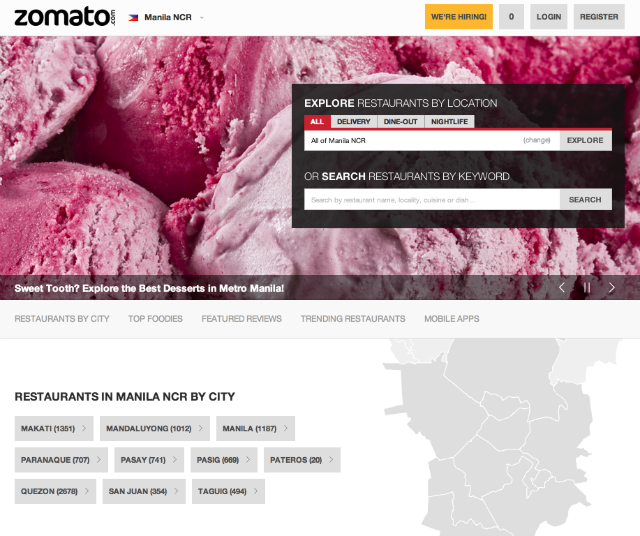Filtered By: Lifestyle
Lifestyle
Pinoy foodies rejoice, Zomato Manila is online
By CARMELA G. LAPEÑA, GMA News
Pinoys love to eat, that's for sure. But when it comes to eating out, they rarely know where to go. "Kahit saan!" a Pinoy will say, or "ikaw bahala." Before you know it, your lunch break is half over, and you still haven't decided where to go.
Pinoys also love the internet. After all, the Philippines has been the world's social media capital since 2010.
Filipinos' love for food and being online are among the reasons that made website and mobile application Zomato choose Metro Manila as its first market in Southeast Asia.

Zomato.com and its mobile apps let foodies explore over 9,000 restaurants in Quezon City, Manila, Makati, Mandaluyong, Parañaque, Pasay, Pasig, Pateros, San Juan, and Taguig.
"Our team spent two weeks in the country and loved it enough to never want to leave. It's always great to be in a cosmopolitan city that loves to eat, and we hope to be an integral part of its dining culture for a long time to come," said CEO Deepinder Goyal, who founded Zomato with Pankaj Chaddah in July 2008 for restaurants in New Delhi.
Zomato has since expanded its services to 20 cities across six countries, covering over 80,000 restaurants.
According to Goyal, the choice for where to launch in Southeast Asia was between the Philippines and Thailand. "However, we found the Philippines to be a bigger market and since Zomato is currently available only in English, we decided to go with the Philippines first," he said.
Dining guide, now mobile
Zomato, an online restaurant and nightlife guide, launched its Metro Manila section last March. With the guide, users can explore over 9,000 restaurants in Quezon City, Manila, Makati, Mandaluyong, Parañaque, Pasay, Pasig, Pateros, San Juan, and Taguig.
"The smartphone penetration in the Philippines is very high and given the fact that the Philippines a very cosmopolitan country that loves to eat makes it a perfect market for a product like ours," Goyal said.
The guide includes scanned menus, photos, mapped coordinates, and user reviews. Users can search according to cuisine, budget, or location, and can refer to ratings and reviews by other users.
"In addition, the rich data on our website which includes photos, menus and geo-coded coordinates can make the decision making process easier for users," Goyal said, adding that this allows Zomato to also act as a platform for restaurants to increase their visibility among foodies.
"Restaurants can also collect feedback from users in the form of reviews and comments," he said.
Goyal noted that Manila has a very active food blogging community, which they hope will be an intergral part of the Zomato dining culture.
Social layers to dining
"We are very excited to be in the Philippines, and hope that the locals like our service and use it to discover great places to eat around them," said Goyal, who described the Zomato platform as “agnostic”, as it can be accessed online or on their free mobile apps (iOS, Android, Windows and Blackberry).
"The social layers on the website also gives us an edge as users can engage with other foodies on Zomato and discover places to eat around them through user recommendations," he said.
Since its launch, Goyal said, the response from Filipinos has been phenomenal. "Although it is too soon to talk about the traffic, we are already getting close to a hundred user reviews on a daily basis," he said.
Zomato plans to further expand its reach into continental Europe, the Middle East, South America and Southeast Asia in 2013.
"We are planning to launch a Thai version of our site shortly, following which we plan to launch in Bangkok, as well," Goyal said. -KDM/BM, GMA News Screenshot image courtesy of Zomato.
More Videos
Most Popular




